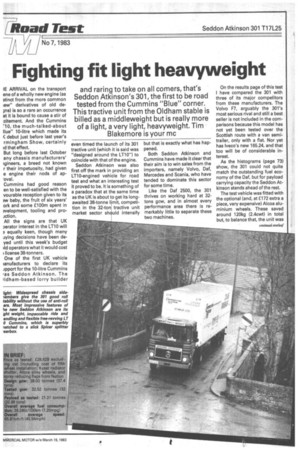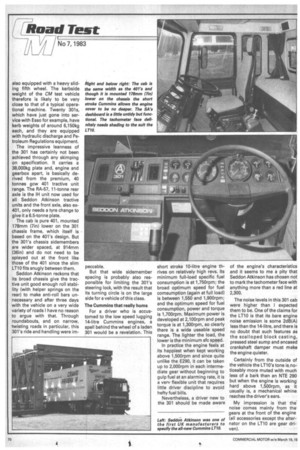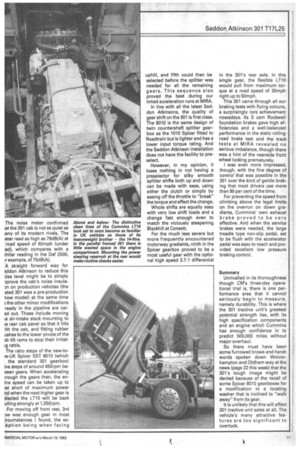Fighting fit light heavyweight
Page 71

Page 72

Page 73

If you've noticed an error in this article please click here to report it so we can fix it.
and raring to take on all corners, that's Seddon Atkinson's 301, the first to be road tested from the Cummins "Blue" corner. This tractive unit from the Oldham stable is billed as a middleweight but is really more of a light, a very light, heavyweight. Tim• Blakemore is your mc
IE ARRIVAL on the transport ene of a wholly new engine (as stinct from the more common iew" derivatives of old dens) is so a rare an occurrence at it is bound to cause a stir of :citement. And the Cummins "10, the much-talked-about Ilue" 10-litre which made its (debut just before last year's rmingham Show, certainly id that effect.
But long before last October any chassis manufacturers' igineers, a breed not known r their impetuosity, had given e engine their nods of ap.oval.
Cummins had good reason en to be well-satisfied with the vourable reception given to its aw baby, the fruit of six years' ork and some £100m spent in avelopment, tooling and proJction.
All the signs are that UK aerator interest in the LT10 will a equally keen, though many uying decisions have been deyed until this week's budget lid operators what it would cost license 38-tonners.
One of the first UK vehicle ianufacturers to declare its J p port for the 10-litre Cummins 'as Seddon Atkinson. The Ildham-based lorry builder
even timed the launch of its 301 tractive unit (which it is said was "designed around the LT10") to coincide with that of the engine.
Seddon Atkinson was also first off the mark in providing an LT10-engined vehicle for road test and what an interesting test it proved to be. It is something of a paradox that at the same time as the UK is about to get its longawaited 38-tonne limit, competition in the 32-ton tractive unit market sector sh uld intensify but that is exactly what has happened.
Both Seddon Atkinson and Cummins have made it clear that their aim is to win sales from the importers, namely Volvo, Daf, Mercedes and Scania, who have tended to dominate this sector for some time.
Like the Daf 2500, the 301 thrives on working hard at 32tons gcw, and in almost every performance area there is remarkably little to separate these two machines.
On the results page of this test I have compared the 301 with three of its major competitors from these manufacturers. The Volvo F7, arguably the 301's most serious rival and still a best seller is not included in the comparisons because this model has not yet been tested over the Scottish route with a van semitrailer, only with a flat. Nor yet has lveco's new 165.24, and that too will be of considerable interest.
As the histograms (page 73) show, the 301 could not quite match the outstanding fuel economy of the Daf, but for payload carrying capacity the Seddon Atkinson stands ahead of the rest.
The test vehicle was fitted with the optional (and, at £172 extra a piece, very expensive) Alcoa aluminium wheels. These saved around 120kg (2.4cwt) in total but, to balance that, the unit was also equipped with a heavy sliding fifth wheel. The kerbside weight of the CM test vehicle therefore is likely to be very close to that of a typical operational machine. Twenty 301s, which have just gone into service with Esso for example, have kerb weights of around 6,150kg each, and they are equipped with hydraulic discharge and Petroleum Regulations equipment.
The impressive leanness of the 301 has certainly not been achieved through any skimping on specification. It carries a 38,000kg plate and, engine and gearbox apart, is basically derived from the premium, 40 tonnes gcw 401 tractive unit range. The RA-57, 11-tonne rear axle is the IH unit now used for all Seddon Atkinson tractive units and the front axle, also ex401, only needs a tyre change to give it a 6.5-tonne plate.
The cab is pure 401, mounted 178mm (71n) lower on the 301 chassis frame, which itself is based on the 401's design. But the 301's chassis sidemembers are wider spaced, at 914mm (36in) and do not need to be splayed out at the front like those of the 401 since the slim LT10 fits snugly between them.
Seddon Atkinson reckons that its broad chassis give the tractive unit good enough roll stability (with helper springs on the rear) to make anti-roll bars unnecessary and after three days with the vehicle on a very wide variety of roads I have no reason to argue with that. Through roundabouts, and on narrow, 'twisting roads in particular, this 301's ride and handling were im peccable.
But that wide sidemember spacing is probably also responsible for limiting the 301's steering lock, with the result that its turning circle is on the large side for a vehicle of this class.
The Cummins that really hums For a driver who is accustomed to the low speed lugging 14-litre Cummins engines, a spell behind the wheel of a laden 301 would be a revelation. This
short stroke 10-litre engine thrives on relatively high revs. Its minimum full-load specific fuel consumption is at 1,750rpm; the broad optimum speed for fuel comsumption (again at full load) is between 1,550 and 1,900rpm; and the optimum speed for fuel consumption, power and torque is 1,700rpm. Maximum power is developed at 2,100rpm and peak torque is at 1,300rpm, so clearly there is a wide useable speed range. The lighter the load, the lower is the minimum sfc speed.
In practice the engine feels at its happiest when kept working above 1,500rpm and since quite unlike the E290, it can be taken up to 2,000rpm in each intermediate gear without beginning to gulp fuel at an alarming rate, it is a very flexible unit that requires little driver discipline to avoid hefty fuel bills.
Nevertheless, a driver new to the 301 should be made aware of the engine's characteristics and it seems to me a pity that Seddon Atkinson has chosen not to mark the tachometer face with anything more than a red line at 2,300.
The noise levels in this 301 cab were higher than I expected them to be. One of the claims for the LT10 is that its bare engine noise emission is some 2dB(A) less than the 14-litre, and there is no doubt that such features as the scalloped block casting, pressed steel sump and encased crankshaft damper must make the engine quieter.
Certainly from the outside of the vehicle the LT10's tone is noticeably more muted with much less of a bark than an NTE 290 but when the engine is working hard above 1,500rpm, as it usually is, a mechanical whine reaches the driver's ears.
My impression is that the noise comes mainly from the gears at the front of the engine (all accessories except the alternator on the LT10 are gear driven).
The noise meter confirmed at the 301 cab is not as quiet as any of its modern rivals. The leter read as high as 79dB(A) at road speed of 60mph (under ,ad), which compares with a miler reading in the Daf 2500, ir example, of 75dB(A).
A straight forward way for 3ddon Atkinson to reduce this )ise level might be to simply iprove the cab's noise insula)n on production vehicles (the sted 301 was a pre-production how model) at the same time ; the other minor modifications ready in the pipeline are cared out. These include moving le air-intake stack mounting to le rear cab panel so that it tilts 'Rh the cab, and fitting rubber ushes to the lower pivots of the ab tilt rams to stop their irritattg rattle.
The ratio steps of the new-tote-UK Spicer SST 8010 (which the standard 301 gearbox) ive steps of around 450rpm beveen gears. When accelerating trough the gears then, the enme speed can be taken up to ist short of maximum power nd when the next higher gear is elected the LT10 will be back ulling strongly at 1,550rpm.
For moving off from rest, 3rd 3w was enough gear in most ircumstances I found, the exeption being when facing
uphill, and fifth could then be selected before the splitter was needed for all the remaining gears. This sequence also proved the best during our timed acceleration runs at MIRA.
In line with all the latest Seddon Atkinsons, the quality of gear shift on the 301 is first class. The 8010 is the same design of twin countershaft splitter gearbox as the 1010 Spicer fitted to Roadtrain but is lighter and has a lower input torque rating. And the Seddon Atkinson installation does not have the facility to preselect.
However, in my opinion, it loses nothing in not having a preselector for silky smooth splitter shifts both up and down can be made with ease, using either the clutch or simply by easing off the throttle to "break" the torque and effect the change.
Whole shifts are equally easy with very low shift loads and a change fast enough even to match the viciously steepening Blackh ill at Consett.
For the much less severe but more frequently encountered motorway gradients, ninth in the Spicer gearbox proved to be a most useful gear with the optional high speed 3.7:1 differential in the 301's rear axle. In this single gear, the flexible LT10 would pull from maximum torque at a road speed of 30mph right up to 50mph.
This 301 came through all our braking tests with flying colours, a surprisingly rare achievement nowadays. Its S cam Rockwell foundation brakes gave high efficiencies and a well-balanced performance in the static rolling road brake test and the track • tests at MIRA revealed no serious imbalance, though there was a hint of the nearside front wheel locking prematurely.
I was even more impressed, though, with the fine degree of control that was possible in the 301 over the kind of gentle braking that most drivers use more than 90 per cent of the time.
For preventing the speed from climbing above the legal limits on the overrun on down gradients, Cummins' own exhaust brake proved to be very effective. And when the service brakes were needed, the large treadle type non-slip pedal, set to be flush with the accelerator pedal was easy to reach and provided excellent, low pressure braking control.
Summary Unrivalled in its thoroughness though CM's three-day operational trial is, there is one performance area that it cannot seriously begin to measure, namely durability. This is where the 301 tractive unit's greatest potential strength lies, with its high specification components and an engine which Cummins has enough confidence in to predict 500,000 miles without major overhaul.
So there must have been some furrowed brows and harsh words spoken down Wolverhampton and Oldham way at the news (page 22 this week) that the 301's tough image might be dented because of the recall of some Spicer 8010 gearboxes for a modification to a locating washer that is inclined to "walk away" from its gear.
It is unlikely that this will affect 301 tractive unit sales at all. The vehicle's many attractive features are too significant to overlook.












































































































